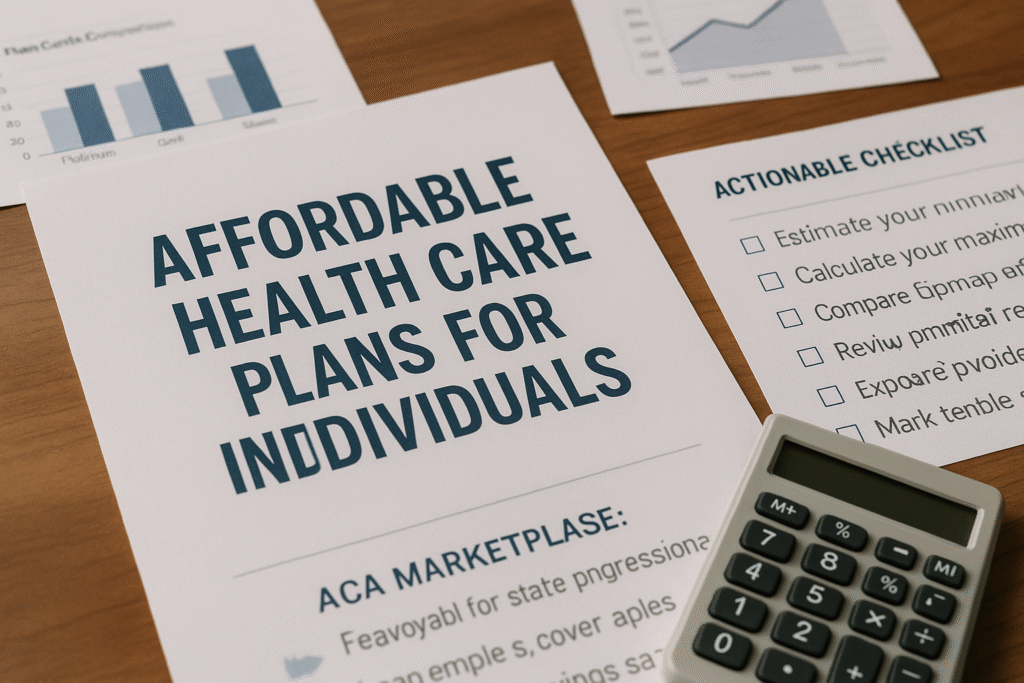Finding an affordable health care plan as an individual can feel overwhelming, especially when trying to balance cost with comprehensive coverage. With rising premiums, evolving policies, and complex plan options, individuals are often forced to make difficult trade-offs. However, affordable health care plans for individuals do exist—and with the right approach, you don’t have to sacrifice essential benefits to stay within your budget.
This in-depth guide will walk you through everything you need to know about finding cost-effective, budget-friendly health insurance options without compromising your health and financial security.
Understanding the Landscape: What Makes Health Care “Affordable”?
Affordable health care isn’t just about the monthly premium. To make an informed decision, individuals must consider:
- Monthly premiums
- Deductibles and copayments
- Out-of-pocket maximums
- Coverage network
- Prescription drug coverage
- Preventive and emergency services
Plans that look cheap upfront may have high deductibles or limited provider networks. Affordability must account for the total cost of care throughout the year. That’s why choosing affordable health coverage for individuals must factor in both immediate costs and long-term health needs.
Explore the ACA Marketplace: Your First Stop
According to the Centers for Medicare & Medicaid Services (CMS), more than 21 million people enrolled in Marketplace coverage during the 2024 open enrollment period—a record high. Nearly 9 in 10 enrollees received financial assistance, significantly reducing their premiums. In fact, the Kaiser Family Foundation (KFF) reports that individuals receiving subsidies paid an average of $74 per month for premiums in 2023, down from over $400 without aid.
The Affordable Care Act (ACA) marketplace is often the best starting point for individuals seeking cost-effective coverage. In 2025, over 24 million Americans enrolled in ACA plans, with nearly 90% receiving some form of subsidy.
Key Benefits of ACA Plans:
- Guaranteed essential health benefits
- No denial for pre-existing conditions
- Tax credits based on income
- Cost-sharing reductions for lower-income individuals
Use the HealthCare.gov website to:
- Compare available low-cost health insurance options in your area
- Estimate your subsidies using the income calculator
- Enroll during the annual Open Enrollment Period (or during a Special Enrollment Period)
Pro Tip:
Even if your income is moderate, you may still qualify for premium tax credits. Visit the KFF Subsidy Calculator to estimate your monthly costs and find affordable individual health plans.
Compare Plan Tiers Strategically: Bronze, Silver, Gold, and Platinum
Marketplace plans are categorized into four “metal” tiers, each balancing monthly premiums with cost-sharing levels:
| Tier | Monthly Premium | Out-of-Pocket Costs | Best For |
| Bronze | Lowest | Highest | Healthy individuals |
| Silver | Moderate | Moderate | Those eligible for subsidies |
| Gold | High | Low | People with frequent healthcare needs |
| Platinum | Highest | Lowest | High-usage patients with minimal cost tolerance |
Silver Plans are often the best option if you’re eligible for cost-sharing reductions, as they offer enhanced benefits at a reduced cost. For many individuals, they represent the most balanced option among affordable health care plans.
Maximize Cost Savings with Health Savings Accounts (HSAs)
If you’re considering a High-Deductible Health Plan (HDHP), pairing it with a Health Savings Account (HSA) can significantly lower your overall expenses.
Benefits of HSAs:
- Tax-free contributions and withdrawals for qualified medical expenses
- Funds roll over annually
- Can be used for future health care needs, even in retirement
HSAs empower individuals to take more control of their health care spending while benefiting from tax advantages, making them a smart add-on for anyone seeking affordable health care coverage.
Alternative Health Coverage Options to Consider
When traditional plans don’t fit, alternative routes can still lead to affordable health insurance for individuals.
1. Short-Term Health Insurance
- Typically offers lower monthly premiums
- Limited benefits; often excludes pre-existing conditions
- Not ACA-compliant
- Ideal for temporary coverage gaps (e.g., between jobs)
2. Health Care Sharing Ministries
- Community-based cost-sharing programs
- Not considered insurance and not regulated by state insurance departments
- May exclude certain services due to religious guidelines
3. Direct Primary Care (DPC) + Catastrophic Plans
- Pay a flat monthly fee to a DPC provider for unlimited visits
- Pair with a catastrophic plan for emergencies
- Offers transparent, predictable costs and personalized care
These models may not work for everyone but can supplement basic coverage or lower costs while still addressing urgent health care needs.
Exploring Local and State-Based Programs
Many states offer their own health exchanges and subsidized insurance programs that can help you find affordable health care plans for individuals with specific eligibility criteria.
- Medicaid expansion in certain states has opened doors to low-income individuals
- State-run plans sometimes offer additional benefits or local provider networks
Be sure to check your state’s Department of Insurance or Health Exchange portal to see what budget-friendly health care options are available in your area.
Employer Alternatives for the Self-Employed
If you’re self-employed or a gig worker, you’re not limited to the ACA marketplace. Here are some additional avenues to explore for affordable health care plans for individuals:
- Professional associations and unions often offer group plans
- Freelance platforms sometimes partner with insurers
- Local Chambers of Commerce may offer group coverage options
These alternatives may give you access to lower premiums and more comprehensive networks, aligning with the goals of individuals seeking affordable, comprehensive coverage.
Special Enrollment Periods (SEPs): Don’t Miss Out
Outside of the standard Open Enrollment Period (OEP), you may qualify for a Special Enrollment Period if you:
- Lose employer-sponsored coverage
- Move to a new state or ZIP code
- Get married or divorced
- Have a baby or adopt a child
Act quickly—SEPs are time-sensitive and typically require action within 60 days of the qualifying event. These windows can provide access to individual insurance plans even if you missed regular deadlines.
Real-Life Examples: Affordable Plans That Don’t Skimp on Coverage
Case Study 1: Sarah, 29, Freelance Graphic Designer
- Income: $30,000/year
- Selected a Silver plan with enhanced cost-sharing reductions
- Monthly premium: $58 after subsidies
- Out-of-pocket maximum: $1,100
- Total savings: Over $3,000 in subsidies
Case Study 2: Mike, 42, Self-Employed Consultant
- Opted for an HSA-compatible Bronze plan
- Contributes $2,000/year to HSA
- Uses funds for prescriptions, dental care, and vision
- Takes a tax deduction on contributions
These examples demonstrate that with careful comparison and financial planning, you can find a health plan that fits your budget and your medical needs—proving that affordable individual health care plans are achievable.
Avoid These Common Mistakes When Shopping for Coverage
- Focusing only on monthly premiums
- Ignoring the provider network
- Overlooking out-of-pocket maximums
- Skipping preventive care coverage
- Missing the enrollment deadline
Making a misstep in plan selection can lead to thousands of dollars in unexpected medical costs. Always review plan documents thoroughly and consult with a licensed insurance advisor if needed.
The Impact of Policy Changes on Affordability
What’s Changing in 2025?
- Enhanced ACA subsidies may expire at the end of 2025, potentially raising premiums for millions.
- Congressional action is pending; it’s crucial to stay informed and act early during open enrollment.
Proposed Reforms:
- Expanding HSA eligibility
- Reinforcing cost-sharing protections
- Boosting Medicaid expansion in non-participating states
Stay ahead of changes by subscribing to updates from CMS and KFF.
Actionable Checklist: How to Choose the Right Affordable Plan
- Estimate your annual health care usage
- Calculate your maximum out-of-pocket exposure
- Check eligibility for ACA subsidies
- Compare metal tiers side-by-side
- Review provider networks and covered prescriptions
- Explore HSAs and tax benefits
- Mark enrollment deadlines on your calendar
Final Thoughts: Your Health is Worth the Investment
Affordable health care plans for individuals don’t require you to compromise on coverage. With tools like ACA marketplaces, HSAs, and informed plan comparisons, individuals can find quality coverage tailored to their budget and health needs.
Whether you’re a freelancer, early retiree, or simply between jobs, there are numerous pathways to affordable health care plans for individuals—if you know where to look and how to evaluate your options. From budget-friendly health insurance to personalized individual medical plans, options are more accessible than ever.
Ready to take control of your health care costs without sacrificing coverage? Start by visiting HealthCare.gov or contact a licensed health insurance broker to compare your options today.
Stay informed, stay covered, and empower your future—one smart health plan at a time.
Sources:
- Centers for Medicare & Medicaid Services (CMS). “2024 Marketplace Open Enrollment Period Report.” https://www.cms.gov
- Kaiser Family Foundation (KFF). “Marketplace Average Premiums and Subsidies.” https://www.kff.org
- HealthCare.gov. “Get 2025 health coverage.” https://www.healthcare.gov







